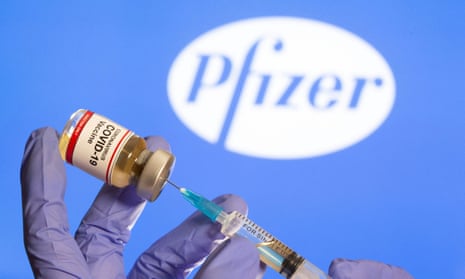News that pharmaceutical giant Pfizer and partner company BioNTech have developed a vaccine that proved 90% effective in protecting people from Covid-19 in global trials has been heralded a “breakthrough”. Pfizer chief executive, Dr Albert Bourla, described the results as “a great day for science and humanity”.
But what do the findings mean for Australia, and for the other Covid-19 vaccines being researched?
There’s very little detail about the results
Acting Victorian chief health officer, Prof Allan Cheng, said while the Pfizer vaccine was good news, there was “very little detail about what the results actually are,” as they have not been published in a peer-reviewed medical journal. The bulk of the findings have been relayed in a Pfizer press release.
“Pfizer say they have analysed 94 Covid cases as part of this trial, but they haven’t even told us about the characteristics of those cases, or what study group they were in. There’s always a lot of criticism of science by media release, because we need to know a lot more about the findings than a press release can provide.”
Prof Lyn Gilbert, chair of Australia’s Infection Control Advisory Group, agreed.
“It certainly sounds promising given it is 90% effective, but these results have not been peer reviewed, and it’s really annoying, actually, when companies report these things in the media before a journal,” she said. “Pfizer is a good company and it’s probably sound, but we really don’t have a lot of detail.”
We need to know more about the vaccine’s safety
Cheng says the key unknown is the safety of the vaccine, including whether there have been adverse events and how serious those side effects are.
There are more than 170 different vaccines in development worldwide, and they work in different ways.
The Australian government’s strategy has been to strike deals with various developers to diversify the vaccine types it gets access to. It now has separate deals with four vaccine developers: AstraZeneca/Oxford University, the University of Queensland, Pfizer, and Novavax.
Those agreements, if all vaccines passed clinical trials, would give Australia access to more than 134m doses of vaccines. The University of Queensland and Novavax are working on protein-type vaccines, and the AstraZeneca Oxford vaccine is an adenovirus vector vaccine.
The Pfizer vaccine is an mRNA-based vaccine candidate. To infect someone, Covid-19 hijacks a cell’s processes in order to replicate itself and infect other cells.
“An mRNA-based vaccine introduces just a tiny bit of the virus, not the whole functional virus, and that is incorporated into the cells,” Cheng said.
“These mRNA-based vaccines are usually pretty reactogenic, so there can be lots of side effects that are usually very mild, such as a more sore arm than usual, and 15-to-20% of people get a fever, which is unusual for a vaccine. If they were the only side effects, most people would be pretty happy with that, but we still need to know.”
The other big question is around the vaccine failure. Of the 10% of people who developed the virus despite receiving the vaccine, how serious was their case of the virus? How long after receiving the vaccine did they become unwell, and how long does the protection last for in those who the vaccine worked on? We don’t have answers.
“The vaccine might be 90% effective early on but what about in six months’ time?” Cheng said.
“The other big question is the storage temperature, given this vaccine needs to be stored around minus 70C. This would make transportation and storage much more difficult.”
Will Australia manufacture this vaccine?
Cheng says this would be highly unlikely in the short term. Australia does not have such a facility for producing this type of unstable, cold-chain vaccine, so a new manufacturing facility with all of the quality safeguards in place would need to be built.
Infectious diseases physician and professor with the Australian National University, Peter Collignon, agreed it would be a huge ask for Australia to produce the Pfizer vaccine locally. “When you needs freezers at minus 70C and to maintain that temperature to delivery, that’s a massive logistical hurdle,” he said.
It can only be stored at 4C for 24 hours maximum. This will pose challenges for mass vaccination campaigns.
“That’s why this should not be seen as the only vaccine,” Collignon said.
“If there are nine billion people in the world and assuming we need two doses for a vaccine to be effective, there will need to be multiple different vaccines and the type of vaccine available somewhere might depend on the manufacturing and distribution choices available.”
Has Australia secured enough doses?
There are some concerns about the volume Australia has secured of the Pfizer vaccine. Its order of 10m doses, at two doses a person, would only be enough for five million Australians, and Pfizer has already struck deals to give hundreds of millions of doses to the United States, Japan and the European Union.
The deal with the US corporate Novavax would give Australia 40m doses, and CSL has agreed to supply 51m doses of the University of Queensland vaccine and 30m doses of the AstraZeneca/Oxford vaccine.
“This points to the importance of having several vaccines available, in order to ensure that everyone around the world will be protected,” Associate Prof Linda Selvey, an infectious diseases epidemiologist at the University of Queensland, said.
“An efficacy of 90% is encouraging, but, in the situation where there are no restrictions on gatherings or movement, this would mean that around 65% of the population would have to be vaccinated in order to stop circulation of the virus [assuming an R0 (reproduction number) of 2.5].”
